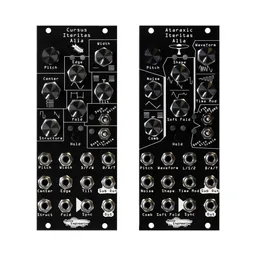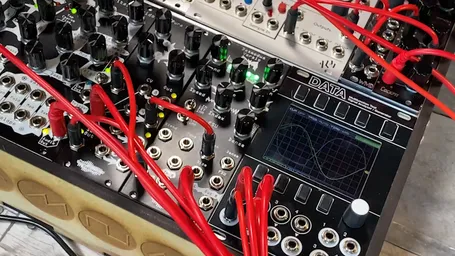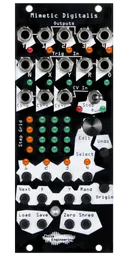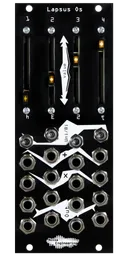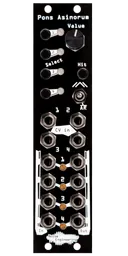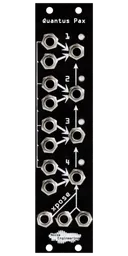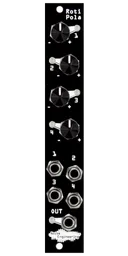Turning one CV signal into a lot of related-but-different CV signals
Confession time: I’m a classically trained musician. Classical composition tends to be based around rigid structure. While I’m now about as far away from being a classical musician as one can possibly be, keeping things structured in my composition and patches is something I have a hard time breaking away from. Simple concepts like returning motifs is something that can add a lot to music, in my opinion. While most commonly a motif refers to a melodic structure, it can really be anything: a rhythm, a call-and-response pattern between multiple voices, or, what we’ll be discussing today: a repeating modulation signal.
I like to use Mimetic Sequent for modulation “motifs”, either randomly creating them within the module or recording them in externally. Another really cool thing that you can do with the techniques we’ll talk about here is use a pitch CV pattern to create a bunch of modulation that’s related to your melody and moves along with it. So let’s get some answers: how can we get more (like, a LOT more) out of one CV source?
The simplest utility we have at our disposal: mults
Being able to make a copy of a signal is very useful, and will be a cornerstone of many of the techniques here. We’ll need lots of copies of our original signal to further manipulate, and splitting other signals down the chain is always helpful, too. I have six mults built into my system, and I like to have Hosa Hopscotch cables on hand, too (especially useful in a small system where a mult would take up too much space). Remember, though, if you’re splitting a pitch signal, you’ll want to use an active mult, otherwise things will probably go out of tune. Mults are your friend! And wouldn’t you know it, we make two modules designed for splitting pitch signals, as well as other doing other things: Quantus Pax and Quant Gemi. QP can split a signal four times, and also sum it with other CV signals (more on that later), and QG can also mult a signal x4, but gives you octave switches. Useful for fun stuff like live transposing to give yourself a little bit more control. Or, if you just need something small and simple, I like the Intellijel Buffered Multiple. If you have a 1u row in your system, they make a 1u version, too.
Learn more:
A simple concept based off a simple utility
Especially if you’re using a pitch sequence as your starting point, splitting your CV signal and routing it to different destinations can give some cool results that emulate the real world. Think about, for instance, a piano: the lower keys sound different than the higher keys, and a similar result can be emulated by multing your pitch signal to a lowpass filter. The higher the note you play, the more the filter will open. Of course, we can use this technique for things that aren’t based on the real world, too, like routing your melody to a wavefolder, or a modulation index, or something else weird and cool. Get creative!
Modifying that CV: attenuation and inversion
While exact copies of a CV signal can be useful, we can also modify our original signal with attenuation and inversion. We make a few modules that can do this, and my favorite for any type of performable patch is the Lapsus Os. It can attenuate and invert with the slide of a fader, so you can manipulate your patch on the fly! Plus, it has a two-way mult built into each channel. It’s a great utility for this sort of thing.
An inverted copy of a signal can be interesting because we can create movement that goes the opposite direction of our original signal. For instance, our low notes could have lots of wavefolding, but our higher notes much less.
Slewing
If we’re using a stepped modulation source like a Mimetic Digitalis, a slew can be an extremely useful utility for making parameter modulation sound smooth instead of choppy. This can sound good on some parameters, and can create a different, more organic feel in a sequence. At extreme settings, slews can give us much broader motion that still reflects what’s going on in our sequence but is much less related. I like to use Mutable Instruments’ Stages for this sort of thing, as each of its six channels can function as a simple slew. Quite handy for smoothing stuff out in creative ways!
Actually generating different CV
While modifying our original CV is well and good, let’s talk about a few ways to get completely new CV from our original sequence.
LFOs/looping envelopes with CV inputs
Sometimes I like to use really slow LFOs in patches just to keep things changing over time. My personal favorite is Pons Asinorum in up/down mode. It can be really, really slow (up to five minutes per cycle) and there are CV inputs that control the time of the envelopes so we can vary their speed based off of our original sequence. Modulating an LFO’s frequency with another CV source is an interesting way of creating evolving and ever-changing modulation that never quite sounds the same. XAOC Devices’ Batumi is another favorite around the office, but you can use any oscillator that goes into LFO range for this, even something simple like a Doepfer A-111-2.
Moving sequencers around
I’ve written a few different blog posts about it so by now it’s no secret, but I really love using Mimetic Digitalis’s CV inputs. We can tune it manually so the steps play values we like for each step, or we can randomize the whole thing, or some of both. It’s a great little utility for stuff like this where we just want a lot more modulation that’s repeatable. This is also a great place for more slews: when using it for modulation I’ll often run some of MD’s outputs to a slew to create nicer sounding/less stepped modulation.
Clock dividers/S&H
Sample-and-hold circuits are a little bit misunderstood (more on that in a future post). Often, people think of them as a source of random voltage, and while that is one of their uses (when combined with a noise source), they can be used for other things, too. S&H circuits have a trigger input, a CV input, and a CV output. When it receives a trigger, it looks at its CV input, and outputs whatever value it received at that exact moment. We can use this for some more CV manipulation: with all of the techniques we’ve talked about above, we have a lot of sources to choose from. We can run one of them through a S&H and trigger it with a clock divider based off the tempo of our original sequence. For instance, we could sample our original melody every four steps to get a countermelody, or just a slower source of stepped CV sequence based on that melody. Again, I like Stages for this because it can also function as up to six S&H’s, if you really want that many (and I definitely have in the past).
Mixing: it’s not just for audio anymore
With the techniques above, we’ve created a ton of different CV sources. And we can combine them in interesting ways to further modify our modulation. We make two modules that are great for this: first, Roti Pola is a four-channel CV mixer with attenuverters for each input. It’s a simple utility that can be super handy for quite a few different applications. And if you want to mix multiple sources of pitch CV and keep it all in tune, Quantus Pax is a precision adder that’s designed just for that. Say you have two pitch sequences coming out of MD: you can then sum them together with one of QP’s channels and get a new, related sequence out of it! What, you don’t have both of those modules, you say?? No problem. Got a Maths? The middle section of Maths can function as a 4-channel CV mixer. Need something more precise? An old favorite module of mine is the Doepfer A-185-2, a precision adder with octave switching built-in and some other cool features. Just one channel, but it does cool things with that single channel.
Don’t forget, you can combine all these different concepts
Since all the techniques we’ve talked about are based off of manipulating a single CV source either directly or to control other CV, you can easily use one of your NEW CV sources and further manipulate it, or use it to modify other stuff, or whatever you want. The chain of CV can be endless!
Let’s actually do some of the stuff we’ve talked about
Here, we’re using one channel of Lapsus Os as our initial CV source. We’re modulating the step position of MD, and the speed of Pons Asinorum’s looping envelopes, as well as using Sinc Bucina as a slew. We’re then modulating Ataraxic Iteritas, and running it through Pura Ruina, Seca Ruina, and our upcoming reverb, also modulated. Lastly, each time LO breaks a certain voltage threshold, it advances Vox Digitalis, creating a slow melody.
